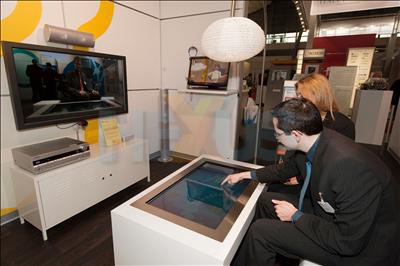Telepresence for the home
Other uses of ACE include ‘living room to living room' communication, with the TV as the probable hub. This is an extension of the kind of thing we're starting to see with Skype embedded in TV sets.
The enhanced sound quality and echo-cancelling offered by Fraunhofer's technology aims to allow groups of people to communicate remotely with each other, but will the sensation of them being in the same, or at least adjacent, rooms.
This sort of technology is already licensed by Cisco for its Telepresence video conferencing offering and it was the focus of Fraunhofer's booth at the recent CeBIT show, as shown in the photo below. "Our target market is to integrate the television into the communication experience," said Baumeister.
It's also part of an EU initiative somewhat cheesily named ‘together anywhere, together anytime' or TA2 for short. The stated aim of the initiative is "making communications and engagement easier among groups of people separated in space and time" and is seems to be designed to try to keep the family unit intact, even when its members are physically separated.
The uptake of this technology will probably be a bit like HD video and TV; many people will be unaware of the need for it until they experience something better. Fraunhofer doesn't reckon there will be much of a cost implication for the adoption of this technology, so it's quite possible that in a few years we'll all be using HD audio instead of boring old vanilla audio.














